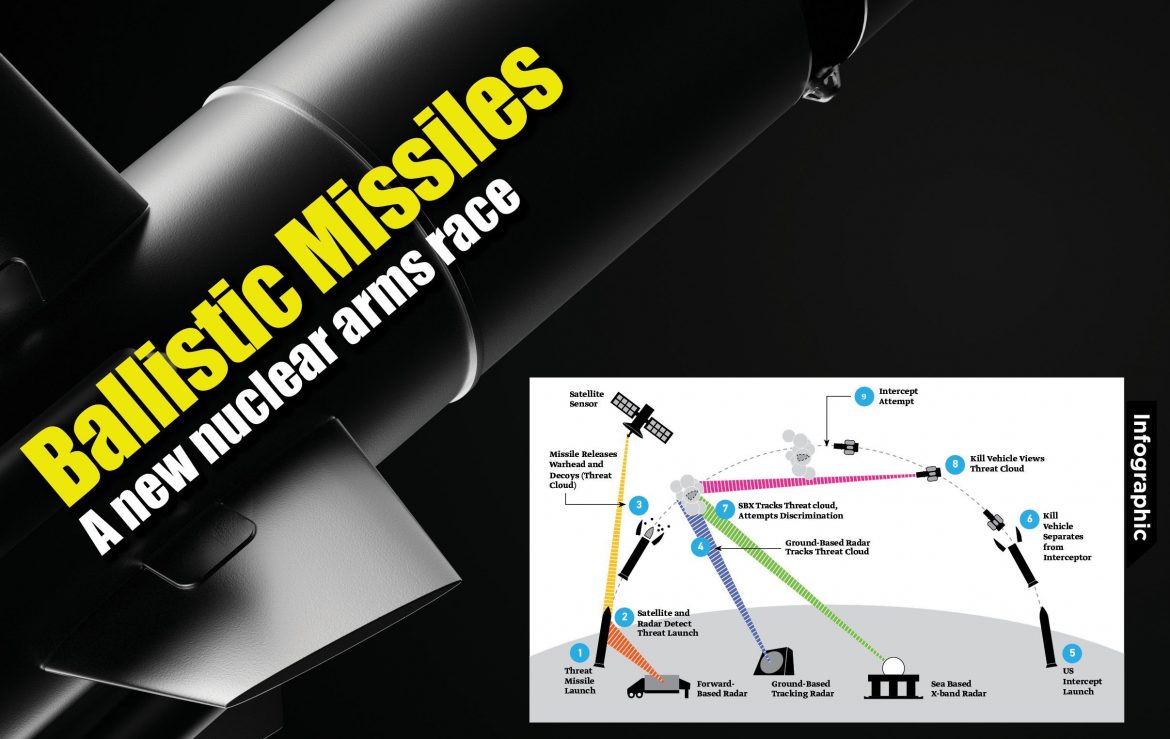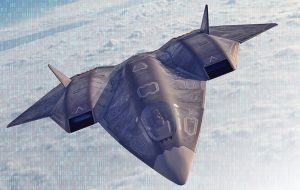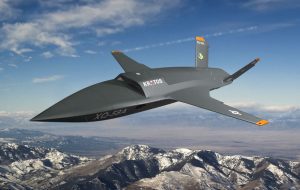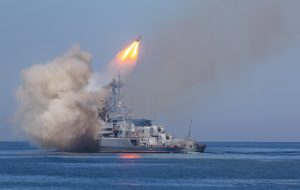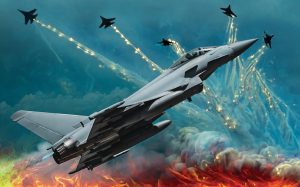Ballistic missiles refer to rocket-propelled strategic weapons that follow an arcing trajectory and fly unpowered once they leave the atmosphere. The ballistic missile can be launched from land, submarines, ships and also from aircrafts. These missiles can ascend to space before descending to the atmosphere at a speed of 420 kilometers per second based on an inertia guidance system. This is explains the arcing trajectory of missiles from the point of their launch to their descent to the atmosphere to hit their target.
Owning ballistic missiles serves to achieve the main goal of deterrence, given the capacity of intercontinental ballistic missiles to carry nuclear warheads, in addition to the difficulty of intercepting them by air defense systems especially after being launched.
Leading Cold War military powers, notably the United States and the Soviet Union, excelled in concealing nuclear weapons in submarines. Moscow in particular hid them in trains that look like freight trains in different Soviet rail networks under the supervisions of specialists in missile strategies. These trains carried in their long wagons RT-23 ballistic missiles which NATO labelled the Scalpel. Its role was to respond to any potential nuclear attack by launching multiple warheads.
Countries use different classifications for ballistic missiles depending on their range. For example, the United States divides missiles into four range classes: Intercontinental ballistic missile (ICBM) which can travel over 5500 kilometers, intermediate-range ballistic missile (IRBM) with a range of 3000 to 5000 kilometers, medium-range ballistic missile (MRBM) with a range of 1000 to 3000 kilometers and short-range ballistic missile (SRBM) with a range of up to 1000 kilometers.
Russia, in particular, developed a system of five-range missiles: Strategic missiles of over 1000 kilometer range, operational-strategic missiles of a range of 500 to 1000 kilometers, operational rockets with a range of 300 to 500 kilometers, operational tactical missiles with a range of 50 to 300 kilometers and tactical missiles with a range of less than 50 kilometers.
The present issue sheds light on ballistic missiles, their genesis, their main components and the main stages in their evolution. It will also offer insight into the main missile types in use currently by the United States, Russia, China and North Korea and will discuss some types of anti-ballistic missile defense systems. The present article also looks at the obstacles to reaching a new anti-ballistic missile treaty to curb expansion of strategic nuclear weapons including intercontinental ballistic missiles.
I. The genesis of ballistic missile production
Germans were the precursors of modern ballistic missiles. Berlin first used ballistic missile V-2, developed by German scientists Walter Dornberger and Wernher von Braun, to attack London in 1944 during the Second World War. The two German scientists were captured and taken to the United States where they designed missiles including those used by the US space agency NASA as part of a secret program dubbed «Operation Paperclip.» Both Washington and Moscow could, within a short period following the Second War, develop their own intercontinental ballistic missiles.
In the Middle East, the first attempts to acquire this type of mighty rockets started with the arms race between Arab countries and Israel, which was the first to develop, in cooperation with French aviation company Dassault, a ballistic missile in 1963 called «Jericho 1.» The missile was designed to equip the Israeli army with additional capacity to attack Arab capitals using missiles carrying warheads. Countries in the frontline with Israel back then: Syria and Egypt, both considered that such missiles can be used to rapidly strike the depth of enemy territories without having to confront the advanced Israeli air force.
Egyptian attempts to develop its own ballistic missiles date back to the late 1960s, when Cairo managed to recruit German rocket scientists who helped Nazi Germany build such missiles during the Second World War. Egypt could in the beginning of the 1960s, with funding from some Arab countries, manufacture missiles dubbed «Adhafer» and «Al-Kaher».
Israel attempted to obliterate the Egyptian missile system but failed. Afterwards, The United States sent its envoy to the Middle East who had talks with Egyptian President Gamal Abdel Nasser in 1964 and persuaded him to give up the development program of ballistic missiles, promising in return that the administration of President Johnson will halt its nuclear program at the Dimona reactor.
Arab states and Israel relied on imported ballistic missiles. The Soviet Union supplied Iraq, Egypt, Syria, Libya and Iran with Scud rockets, while the United States continues to provide Israel with Lance missiles.
II. Ballistic missile components:
Every ballistic missile has three main component: propulsion, guidance and load systems which can be explained as follows:
1 Propulsion System: The propulsion of ballistic missiles takes place as a result of the combination of fuel and an oxidizer which releases at the combustion level a high pressure and high temperature gas that generates thrust which in turn puts the rocket in motion. Sometimes a catalyst is added to enhance the chemical reaction between the fuel and the oxidizer. There are four types of chemical fuel used for missile engines: liquid, solid, hybrid and nuclear. Each have advantages and disadvantages which make it more suitable for specific uses than others:
A. Liquid propellant rockets: These are equipped with engines that burn two liquid chemicals stored separately: fuel and oxidizer, in order to generate thrust.
B. Solid propellant rockets: These combines the two chemicals in solid cylinders because the mix does not burn in normal temperature but rather once exposed to heat triggered by an igniter. Once combustion starts, it continues until all fuel is consumed.
The two systems have pros and cons. In liquid propellant rockets, thrust can be halted by cutting off the flow of fuel. Whereas, in solid propellant rockets, the only way to stop the engine is by destroying it. On the other hand, liquid propellant rockets tend to be heavier and more complicated because of the pumps and storage rooms, as they carry a mix of fuel and oxidizer prior to the launch. Therefore, liquid propellant rockets face enormous storage problems.
By contrast, solid propellant rockets are easier to use and can be stored for years before deployment.The raw material of the liquid fuel, like oxygen and hydrogen, are in abundant supply and comparatively easier to manufacture. Most countries tend to use solid fuel because of its fewer logistics requirements and easy operation. But, some countries are still working towards developing liquid propellant rockets.
C. Hybrid propellant rockets: Use engines that try to capture the advantages of both liquid and solid fueled rocket engines. The main design of a hybrid consists of a combustion chamber tube, similar to ordinary solid fueled rockets, packed with a solid chemical, usually the fuel. Above the combustion chamber tube is a tank, containing a complementary reactive liquid chemical, usually the oxidizer. The two chemicals are hypergolic, and when the liquid chemical is injected into the combustion chamber containing the solid chemical, ignition occurs and thrust is produced.
The ability to throttle the engine is achieved by varying the amount of liquid injected per unit of time. The rocket engine can be stopped by cutting off the flow of the liquid chemical. The engine can be restarted by resuming the flow of the liquid chemical. Other advantages of hybrid propellant rocket engines are that they provide higher energy than standard solid propellant rockets, they can be stopped and restarted like liquid propellant rockets, they can be stored for longer periods like solid propellant rockets, and they contain less than half the complex machinery (like pumps) of standard liquid propellant engines.
Hybrid rockets control the combustion rate by metering the liquid component of the fuel. No matter how much solid component surface area is exposed, only so much can be burned in the presence of the liquid component. Disadvantages are that these engines do not generate as much energy per pound of propellant as liquid propellant engines and they are more complex than standard solid fueled engines. Hybrid propellant rocket engines are still in development and are not yet available for operational use.
D. Nuclear powered propulsion: A nuclear-powered rocket engine does not use energy generated through combustion to propel a missile forward. Instead, it does so by relying on heat generated through ongoing nuclear fission. Following the Second World War, both the United States and the Soviet Union unsuccessfully experimented with nuclear-powered aircraft and carrier rockets.
2 Guidance system: The guidance system aims to control the flight path so that ballistic missiles can hit their targets with the required speed and accuracy. The missile is equipped with sensors and a flight speed control system. An integrated computer monitoring the state of the missile, its speed, position and direction, sends messages to the control system in order to correct any deviations in the flight path.
3 Ballistic missiles can deliver a variety of payloads whether conventional, nuclear, chemical or biological. The chemical and biological loads can be combined in short-range missile systems.
III. Stages of ballistic missile flight:
Ballistic missiles have three stages of flight which can be explained as follows:
1 Boost phase: The boost phase starts after the launch and lasts until the rocket engine stops firing and the missile begins unpowered flight away from earth. Based on the missile type, this phase lasts for three to five minutes mostly within the atmosphere, as the rocket cruises at a comparatively lower speed.
The intercontinental ballistic missile is pushed by the propellant rocket to ascend. An intercontinental missiles may require up to three propellant rockets which are disposed one by one once they have been burnt in the combustion phase.
Intercontinental ballistic missiles can be launched from underground silos or from mobile platforms on roads, rails and submarines. Mobile intercontinental ballistic missiles are usually more difficult to detect and to obliterate prior to their launch.
2 Midcourse Phase: This phase starts after the rocket stops its firing systems. At this stage, the rocket is already following a ballistic course towards its target. This is the longest phase in the course of the missile which can last up to 20 minutes for intercontinental ballistic missiles. In the first stage of this phase, the missiles ascends to the highest point in its flight before it starts, in the terminal stage, descending towards earth with its warheads detached as well as delivery platforms. This process happens in the Endoatmospheric layer. The warhead at this level is called a reentry vehicle. The intercontinental ballistic missile can travel at more than 24,000 at this stage thanks to inertia law.
3 Terminal phase: The terminal Phase begins when the detached warhead(s) or the re-entry vehicle reaches the earth’s atmosphere and ends upon impact or detonation. During this phase, which can last for less than a minute, strategic warheads can travel at a speed greater than 3,200 kilometers per hour.
The extreme heat that the missile encounters once it enters the atmosphere can burn or destroy it if it does not have chassis that can support high temperature.
IV.Main ballistic missile types:
The Intercontinental Ballistic Missiles, or ICBMs, were designed to carry nuclear weapons. These deadly missiles have a minimum range of 5500 km. Typically, these missiles can carry more than one nuclear warhead. Most modern designs support multiple independently targetable Re-entry Vehicles (MIRVs). This means that a single missile can deliver multiple warheads. Each of which can be directed to hit a different target. Moreover, Intercontinental ballistic missiles carry an array of decoys, that allow to overcome enemy air defenses.
Among the mightiest intercontinental ballistic missiles we can cite:
1 Trident: The Trident is an intercontinental ballistic missile that was first deployed in 1990. This solid fuel missile has been deployed by the United States on board its Ohio submarines. UK trident missiles are carried by Vanguard class submarines. These missile can also be silo-based. Trident missile stretch for 13.42 meters with a diameter of 2.11 and a weight at launch of 59 kilograms. It can carry up to 8 Mark-5 nuclear warheads and it has a range of 2000 to 12,000 kilometers.
Trident II in particular has a range of 7800 kilometers with full load and 12000 with lower load. Although Trident II has not the longest range in comparison with other intercontinental ballistic missiles, submarines equipped with this type of missiles can always approach their targets, to reduce the flight range of ballistic missiles. Trident II can carry up to 14 warheads each with a 475 yield. However, START I agreements reduced the number of warheads a ballistic missile can carry to 8 only.
Re-entry vehicles are designed to maneuver on their way back to the atmosphere in order to eschew enemy air defense systems. Each vehicle takes an independent flight course. British missiles use locally-built re-entry vehicles. Reportedly, British missiles can carry up to 12 warheads per missile.
Trident II is a very accurate missile. It has a probable circular error (CEP) of around 90 meters only. It is guided on its target using the astro-inertial navigation system. It can also be equipped with GPS updates.
The Trident II outperforms other ballistic missiles because it can be launched from submarine that are hard to detect at sea. This has given a lethal edge to these missiles. But due to the capacity of enemies to detect and target using nuclear missiles the positions of silo-based ballistic missiles, ballistic submarines equipped with Trident II has higher chances to survive the first strike, once the country has been under attack. It is expected that updated Trident II missiles will remain in service until 2042.
2 RS-24 Yars: The RS-24 Yars is a solid-fuel Russian intercontinental ballistic missile. It was developed based on an older version dubbed RS-12M Topol-M and it can carry multiple warheads. The Russian armed forces had 101 such missile systems in 2017. The Yars system will account for half of Russia’s strategic missiles by 2021.
This missile has a range of 12,000 kilometers. Yars performs maneuvers during its flight and carries both active and passive decoys. Reports showed that it has a chance of at least 60 to 65% to penetrate defense systems.
Russia developed two versions of this missile. The first can be launched from mobile platforms that uses the same highly mobile 16×16 wheeled chassis, similar to Topol M. Such road-mobile intercontinental ballistic missiles are hard to detect and attack, because this system has high probability in surviving a first nuclear strike.
Yars systems also have a silo-based version. Russia adopted deployed these missiles in 2010. In 2016, Russian forces deployed 63 mobile missiles and 10 Yars intercontinental ballistic missiles.
The main difference between Topol-M and Yars is that the latter is equipped with multiple independently targetable re-entry vehicles. Yars missiles can carry at least 6 independently targetable warheads with a 100 to 300 kt yield. Some reports suggest that this missile can carry 10 re-entry vehicles. This is very likely given that the previously mentioned Topol-M can carry 10 warheads. This missile has a probable circular error of 150 to 200 meters.
In 2019, the Avangard hypersonic re-entry vehicle was unveiled as operational on Yars systems. The Avangard can perform agile maneuvers. Some sources said its speed can reach up to 33,300 kilometers per hour (Mach 27). This missiles are hard to target by conventional interceptor missiles due in part to its speed of 6173 kilometers per hour (Mach 5). Moreover, Avangard has an unpredictable ballistic trajectory unlike other ballistic missiles. It was planned that 31 Yars missiles will be equipped with Avangard re-rentry vehicles.
3 Sarmat RS- 28: Sarmat RS-28, referred to by NATO as Satan-2, is a liquid-fuel Russian intercontinental ballistic missile that is able to carry out trajectories over the North Pole or the South Pole. With a range of over 11,000 kilometers, this missile can carry mighty nuclear warheads weighing 10 tons. Sarmat RS-28 can carry around 10 heavy re-entry vehicles or alternatively 16 lighter ones or a mix of heavy and light warheads as well as defense systems. This missile is the biggest of its kind in history. Other missile details remain shrouded in secrecy.
Sarmat can defeat all current missile defense systems in the world. No defense system can track or destroy tens of nuclear warheads each, following an independent ballistic winding trajectory, ascending and descending while avoiding mountains which these missiles can use as cover with a capacity to fly at hypersonic speed if necessary but also at lower speed.
Concerning its impact, Russian Sarmat missiles can destroy an area the size of France or Texas and it can reach Western American coast within 12 minutes of its launch. Sarmat can carry warheads weighing 40 megatons with a destructive impact that is 2000 times higher compared with the nuclear bombs dropped on Hiroshima and Nagasaki in 1945.
4 China’s DF-41 is one of the most advanced intercontinental ballistic missiles ever made. It is also one of the deadliest in the world. It is launched from an 8-axle vehicle. This Chinese missile is similar in concept to Russia’s road-mobile intercontinental ballistic missiles such as Topol-M and Yars.
In 2013, this missile was first test launched. The second test took place in 2014. Some sources reported that another version of the missile, DF-41, was tested in 2016 or 2017.
DF-41 is a solid-fuel missile with a range of 12,000 kilometers and can carry up to 10 independently targetable Re-entry Vehicles. This type of missiles can reach points across the US territory, Europe and Russia. It takes 20 to 25 minutes for these missiles to reach targets in the United States. DF-41 can devastate entire countries.
This missile is equipped with an internal navigation system benefiting from an update of China’s satellite BeiDou. Its accuracy rate is up to 150 meters. The DF-41 is based on Taian HTF5980 special wheeled chassis with 16 wheels. This vehicle is able to travel through difficult terrains. China has acquired a set of high-mobility vehicle chassis technology from Belorussia’s MZKT firm. A joint project was set up between China and Belorussia to manufacture wheeled chassis in China.
China thus became the second country after Belorussia in terms of having capability to design and produce launch vehicles for super-heavy intercontinental missiles. Even Russia, that historically uses road-mobile intercontinental ballistic missiles, lacks this technology and expertise which it imports from Belorussia.
This Chinese road-mobile intercontinental ballistic missiles are stored in tunnels, which makes them well protected. Once the state of alert has been declared, the vehicle launchers leave the tunnels and launch the missile from nearby positions. The vehicles can also leave their bases and operate without being detected in remote areas. This makes them difficult to intercept and destroy compared with stationary silo-based missiles.
5 Hwasong 16: North Korea unveiled its intercontinental ballistic missile Hwasong 16 in October 2020 during a huge military parade on the occasion of the 75th anniversary of the Korea Workers’ party.
The missile has been designated as Hwasong 16 by Western experts. This is considered the largest intercontinental ballistic missile in the world and it can carry up to 4 conventional or nuclear warheads and multiple re-entry vehicles. It also has a capacity to reach targets all over the United States territory and can defeat all American missile defense systems.
The new missile was displayed on board an 11-axel vehicle with 22 wheels. It has a length of 26 meters, i.e., 15% longer than its predecessor Hwasong 15, and a diameter of 2.9 meters. It weights between 100,000 and 150,000 kilograms with a range of 130,000 kilometers, similar to Hwasong 15. It is reported that it has a larger load capacity. The missile, considering its diameter, is equipped with 4 RD-250 Soviet engines.
V. Ballistic missile defense
systems:
The importance of anti-ballistic missile air defense systems stems from being one of the main pillars of nuclear deterrence. Counties which own such air defense systems have a nuclear edge of their enemies, considering their capacity to destroy all ballistic missiles carrying nuclear warheads. Theoretically, these countries are also capable of operating ballistic missiles to respond to their enemies.
The US has been developing defense systems to intercept any sort of ballistic missiles. In 2017, the United States confirmed that its interceptor rockets based in Alaska and California are assessed to have a 25% chance of a head-on collision with the attacking missile. However, most experts believe that the actual performance is much lower, especially if operated under real-world conditions wherein the trajectory of the missile is not known in advance.
This assessment was based on a Pentagon’s 2016 report which confirmed the low reliability of the performance of the ground-based interceptors. The report also said that the Missile Defense Agency continues to find new pitfalls during testing. In this respect, Mark Esper, former US Defense Secretary, said in October 2020 that it is a priority for the United States to improve its missile defense capabilities in order to counter Russian and Chinese medium-term ballistic missile threats. This means that American missile defense systems are yet to be fully capable of intercepting ballistic missiles. This is a point we shall explain later.
Every missile defense systems has components that we can explain accordingly:
1 Ground-based, satellite and sea-based radars: Usually states a combination of satellite interceptors as well as ground-based and sea-based radars in order to set up a comprehensive monitoring systems that can intercept ballistic missiles once they are launched. This system is also designed to distinguish between genuine and fake threats in addition to tracking the trajectory of the attacking missiles so that the intercepting rocket can find it and obliterate it.
2 Interceptor missiles: Interceptor missiles are also known as lethal vehicles. It can be detached from the rocket that carries it in order to hit hostile ballistic missiles in a motion known as «Hit to Kill.» It is noticed however that some interceptor missiles are made as a unique piece which make it unable to detach from the lethal vehicle.
In this regards, Patriot Pac-3 and THAAD are among the most effective ballistic missile defense systems along with Aegis, which can be deployed on board US ships. However, these three systems intercept only short- and medium-range missiles moving at slower speeds and lower altitudes than intercontinental ballistic missiles.
The US is currently developing its strategic missile defense which aims at destroying intercontinental ballistic missiles during their mid-course phase, using ground-based interceptor missiles.
Russia, for its part, has an anti-ballistic missile defense system known as S-400 Triumf. Moscow is also developing PL-19 Nudol missiles designed to intercept ballistic missiles at higher altitudes. It can also be used to destroy satellites. Moscow affirms that S-500 is able to destroy intercontinental ballistic missiles outside the atmosphere, adding this ballistic defense system is able to down 10 long-range missile at once even if attacking missiles cruised at a speed of between 18,000 and 25,000 kilometers. This system is also capable of destroying missiles and aircrafts cruising at an altitude of 200 kilometers. It is worth mentioning here that this system is still under development and is expected to be deployed in 2021.
These interceptor missiles can be launched from underground silos or road-mobile vehicles and ships. For now, there are no satellites that are able to carry rockets that can intercept ballistic missiles. In the 1980s, several politicians suggested the idea of «space-based missile defense» using missile interceptors stationed in orbit around the earth to knock down attacking missiles.
A hypothetical benefit of such a system is that it is at bay from the countermeasures which undermine the effectiveness of the current ground-based anti-ballistic missile systems. The main flaw of this system, however, is that satellite defenses can be targeted by anti-satellite missile systems. It may also trigger a reaction from China, Russia.
Russia and the US continue to trade accusations over the deployment of weapons in the outer space. The most recent accusations were directed by Moscow to Washington in February 2020, after the US unveiled its new space power doctrine.
Separately, efforts are ongoing to develop new defense systems capable of intercepting ballistic missiles. The Pentagon has announced that it has introduced updates to its F-35 fighter jet to improve its maneuverability in eschewing and tracking ballistic missiles. In July 2019, Israel announced the success of its Arrow-3 ballistic missile defense system, which it developed in cooperation with US Boeing. During tests in Alaska, Arrow-3 system successfully knocked down target ballistic missiles outside the atmosphere at a high altitude that enable the destruction of any non-conventional warheads at unprecedented speed.
States use different ways to overcome ballistic missile defense systems including decoys that can easily defeat missile defenses.
3 Guidance and control systems: In these systems, all data is collected and processed through interceptor devices and radars and sent to interceptor missiles and kill vehicles through a command and control network. These systems are positioned in different points within a state. The inflow of data is being processed by the interceptor devices using advanced artificial intelligence to facilitate decision-making.
VI. Curbing race over ballistic missiles :
International treaties are one of the means used by global powers to limit the arms race over ballistic missiles, particularly intercontinental ones. New Start is a salient example. It was signed in 2010 to reduce the strategic offensive arms of the US and Russia to lower levels compared to the Cold War. It restricted the number of heavy bombers equipped for nuclear armaments to 700 and limited nuclear warheads to 1550.
The Treaty will expire in early 2021. There have been attempts to seal a new treaty under the administrations of Barack Obama and Dmitry Medvedev but no breakthrough was made. This treaty remains however key to curb the nuclear arms race between the two key global powers which together own more than 90% of the world’s nuclear arms, according to the Stockholm International Peace Research Institute (SIPRI).
One of the reasons that impeded an agreement is the US insistence on the inclusion of China, considering Beijing’s rapidly developing nuclear arsenal. China, however, refuses to engage in the treaty arguing that its nuclear arsenal is much smaller compared to that of the United States and Russia. It also rejects participation in a trilateral agreement. Up to 2020, Washington has 5800 nuclear warheads, while Moscow has 6375. Beijing has 320, Paris 290 and London 215, according to Sweden’s SIPRI.
In light of the above details, we can say that rivalry to develop a new ballistic system will become rifer at a faster pace, in case the United States, Russia and China fail to reach an agreement to limit nuclear armament and strategic ballistic missiles production.


